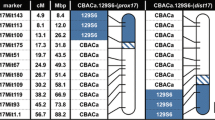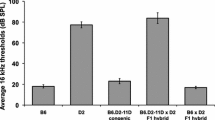Abstract
Noise-induced hearing loss (NIHL) is a prevalent health risk. Inbred mouse strains 129S6/SvEvTac (129S6) and MOLF/EiJ (MOLF) show strong NIHL resistance (NR) relative to CBA/CaJ (CBACa). In this study, we developed quantitative trait locus (QTL) maps for NR. We generated F1 animals by intercrossing (129S6 × CBACa) and (MOLF × CBACa). In each intercross, NR was recessive. N2 animals were produced by backcrossing F1s to their respective parental strain. The 232 N2-129S6 and 225 N2-MOLF progenies were evaluated for NR using auditory brainstem response. In 129S6, five QTL were identified on chromosomes (Chr) 17, 18, 14, 11, and 4, referred to as loci nr1, nr2, nr3, nr4, and nr5, respectively. In MOLF, four QTL were found on Chr 4, 17, 6, and 12, referred to as nr7, nr8, nr9, and nr10, respectively. Given that NR QTL were discovered on Chr 4 and 17 in both the N2-129S6 and N2-MOLF cross, we generated two consomic strains by separately transferring 129S6-derived Chr 4 and 17 into an otherwise CBACa background and a double-consomic strain by crossing the two strains. Phenotypic analysis of the consomic strains indicated that whole 129S6 Chr 4 contributes strongly to mid-frequency NR, while whole 129S6 Chr 17 contributes markedly to high-frequency NR. Therefore, we anticipated that the double-consomic strain containing Chr 4 and 17 would demonstrate NR across the mid- and high-frequency range. However, whole 129S6 Chr 17 masks the expression of mid-frequency NR from whole 129S6 Chr 4. To further dissect NR on 129S6 Chr 4 and 17, CBACa.129S6 congenic strains were generated for each chromosome. Phenotypic analysis of the Chr 17 CBACa.129S6 congenic strains further defined the NR region on proximal Chr 17, uncovered another NR locus (nr6) on distal Chr 17, and revealed an epistatic interaction between proximal and distal 129S6 Chr 17.









Similar content being viewed by others
References
Abi-Hachem RN, Zine A, Van De Water TR (2010) The injured cochlea as a target for inflammatory processes, initiation of cell death pathways and application of related otoprotectives strategies. Recent Pat CNS Drug Discov 5:147–163
Broman KW, Wu H, Sen S, Churchill GA (2003) R/qtl: QTL mapping in experimental crosses. Bioinformatics 19:889–890
Candreia C, Martin GK, Stagner BB, Lonsbury-Martin BL (2004) Distortion product otoacoustic emissions show exceptional resistance to noise exposure in MOLF/Ei mice. Hear Res 194:109–117
Churchill GA, Doerge RW (1994) Empirical threshold values for quantitative trait mapping. Genetics 138:963–971
Fetoni AR, De Bartolo P, Eramo SL, Rolesi R, Paciello F, Bergamini C, Fato R, Paludetti G, Petrosini L, Troiani D (2013) Noise-induced hearing loss (NIHL) as a target of oxidative stress-mediated damage: cochlear and cortical responses after an increase in antioxidant defense. J Neurosci: Off J Soc Neurosci 33:4011–4023
Flaherty JP, Fairfield HE, Spruce CA, McCarty CM, Bergstrom DE (2011) Molecular characterization of an allelic series of mutations in the mouse Nox3 gene. Mamm Genome: Off J Int Mamm Genome Soc 22:156–169
Flint J, Valdar W, Shifman S, Mott R (2005) Strategies for mapping and cloning quantitative trait genes in rodents. Nat Rev Genet 6:271–286
Henderson D, Bielefeld EC, Harris KC, Hu BH (2006) The role of oxidative stress in noise-induced hearing loss. Ear Hear 27:1–19
Hirose K, Liberman MC (2003) Lateral wall histopathology and endocochlear potential in the noise-damaged mouse cochlea. J Assoc Res Otolaryngol: JARO 4:339–352
Hirose K, Discolo CM, Keasler JR, Ransohoff R (2005) Mononuclear phagocytes migrate into the murine cochlea after acoustic trauma. J Comp Neurol 489:180–194
Johnson K (2014) Hereditary hearing impairment in mice. In. http://hearingimpairment.jax.org/index.html: The Jackson Laboratory. Accessed 20 January, 2014
Kiss PJ, Knisz J, Zhang Y, Baltrusaitis J, Sigmund CD, Thalmann R, Smith RJ, Verpy E, Banfi B (2006) Inactivation of NADPH oxidase organizer 1 results in severe imbalance. Curr Biol: CB 16:208–213
Kujawa SG, Liberman MC (1997) Conditioning-related protection from acoustic injury: effects of chronic deefferentation and sham surgery. J Neurophysiol 78:3095–3106
Kujawa SG, Liberman MC (2009) Adding insult to injury: cochlear nerve degeneration after "temporary" noise-induced hearing loss. J Neurosci: Off J Soc Neurosci 29:14077–14085
Kujawa SG, Liberman MC, Wood ML, Tempel BL (2007) Noise-induced hearing loss variation within and between inbred strains of mice. In: Association for Research in Otolaryngology, Abstract 637
Lander ES, Botstein D (1989) Mapping mendelian factors underlying quantitative traits using RFLP linkage maps. Genetics 121:185–199
Lu J, Cheng X, Li Y, Zeng L, Zhao Y (2005) Evaluation of individual susceptibility to noise-induced hearing loss in textile workers in China. Arch Environ Occup Health 60:287–294
Manji SS, Williams LH, Miller KA, Ooms LM, Bahlo M, Mitchell CA, Dahl HH (2011) A mutation in synaptojanin 2 causes progressive hearing loss in the ENU-mutagenised mouse strain Mozart. PLoS One 6:e17607
Mashimo T, Erven AE, Spiden SL, Guenet JL, Steel KP (2006) Two quantitative trait loci affecting progressive hearing loss in 101/H mice. Mamm Genome: Off J Int Mamm Genome Soc 17:841–850
Morita Y, Hirokawa S, Kikkawa Y, Nomura T, Yonekawa H, Shiroishi T, Takahashi S, Kominami R (2007) Fine mapping of Ahl3 affecting both age-related and noise-induced hearing loss. Biochem Biophys Res Commun 355:117–121
Nakano Y, Kim SH, Kim HM, Sanneman JD, Zhang Y, Smith RJ, Marcus DC, Wangemann P, Nessler RA, Banfi B (2009) A claudin-9-based ion permeability barrier is essential for hearing. PLoS Genet 5:e1000610
Nelson DI, Nelson RY, Concha-Barrientos M, Fingerhut M (2005) The global burden of occupational noise-induced hearing loss. Am J Ind Med 48:446–458
Nemoto M, Morita Y, Mishima Y, Takahashi S, Nomura T, Ushiki T, Shiroishi T, Kikkawa Y, Yonekawa H, Kominami R (2004) Ahl3, a third locus on mouse chromosome 17 affecting age-related hearing loss. Biochem Biophys Res Commun 324:1283–1288
NIDCD (2000) Have wise ears for life. In: NIH Publication No. 00–4848. http://www.nidcd.nih.gov/health/hearing/pages/wiseears.aspx: National Institute on Deafness and other Communication Disorders
Noben-Trauth K, Johnson KR (2009) Inheritance patterns of progressive hearing loss in laboratory strains of mice. Brain Res 1277:42–51
Ohinata Y, Yamasoba T, Schacht J, Miller JM (2000) Glutathione limits noise-induced hearing loss. Hear Res 146:28–34
Ohlemiller KK, Rybak Rice ME, Rellinger EA, Ortmann AJ (2011) Divergence of noise vulnerability in cochleae of young CBA/J and CBA/CaJ mice. Hear Res 272:13–20
Peppi M, Kujawa SG, Sewell WF (2011) A corticosteroid-responsive transcription factor, promyelocytic leukemia zinc finger protein, mediates protection of the cochlea from acoustic trauma. J Neurosci: Off J Soc Neurosci 31:735–741
Rabinowitz PM (2012) The public health signficance of noise-induced hearing loss. In: Noise-Induced Hearing Loss: Scientific Advances, Springer Handbook of Auditory Research (Le Prell CG, Henderson D, Fay RR, Popper AN (ed), Springer Science and Business Media, LLC, pp 13–25
Reed SC (1937) The inheritance and expression of fused, a new mutation in the house mouse. Genetics 22:1–13
Sautter NB, Shick EH, Ransohoff RM, Charo IF, Hirose K (2006) CC chemokine receptor 2 is protective against noise-induced hair cell death: studies in CX3CR1(+/GFP) mice. J Assoc Res Otolaryngol: JARO 7:361–372
Schacht J, Altschuler R, Burke DT, Chen S, Dolan D, Galecki AT, Kohrman D, Miller RA (2012) Alleles that modulate late life hearing in genetically heterogeneous mice. Neurobiol Aging 33(1842):e1815–e1829
Shin JB, Longo-Guess CM, Gagnon LH, Saylor KW, Dumont RA, Spinelli KJ, Pagana JM, Wilmarth PA, David LL, Gillespie PG, Johnson KR (2010) The R109H variant of fascin-2, a developmentally regulated actin crosslinker in hair-cell stereocilia, underlies early-onset hearing loss of DBA/2 J mice. J Neurosci: Off J Soc Neurosci 30:9683–9694
Wang Y, Liberman MC (2002) Restraint stress and protection from acoustic injury in mice. Hear Res 165:96–102
Wang Y, Hirose K, Liberman MC (2002) Dynamics of noise-induced cellular injury and repair in the mouse cochlea. J Assoc Res Otolaryngol: JARO 3:248–268
Xu S, Atchley WR (1996) Mapping quantitative trait loci for complex binary diseases using line crosses. Genetics 143:1417–1424
Yamasoba T, Schacht J, Shoji F, Miller JM (1999) Attenuation of cochlear damage from noise trauma by an iron chelator, a free radical scavenger and glial cell line-derived neurotrophic factor in vivo. Brain Res 815:317–325
Yoshida N, Hequembourg SJ, Atencio CA, Rosowski JJ, Liberman MC (2000) Acoustic injury in mice: 129/SvEv is exceptionally resistant to noise-induced hearing loss. Hear Res 141:97–106
Zheng QY, Johnson KR, Erway LC (1999) Assessment of hearing in 80 inbred strains of mice by ABR threshold analyses. Hear Res 130:94–107
Acknowledgments
This work was supported by grants from the NIH including R21DC04983 (SGK), R01DC06305 (BLT), R01DC08577 (SGK), R01DC02739 (BLT), R01DC00188 (MCL), P30DC04661 (BLT), P30DC05209 (MCL), R01GM074244 (KWB), and DoD DM102092 (BLT). Additional support provided by an NSF Graduate Research Fellowship (AM) and a Howard Hughes Medical Institute Medical Research Fellow (AJI).
Conflict of Interest
The authors have declared that no competing interests exist.
Author information
Authors and Affiliations
Corresponding author
Additional information
Valerie A. Street and Sharon G. Kujawa contributed equally to this work.
Rights and permissions
About this article
Cite this article
Street, V.A., Kujawa, S.G., Manichaikul, A. et al. Resistance to Noise-Induced Hearing Loss in 129S6 and MOLF Mice: Identification of Independent, Overlapping, and Interacting Chromosomal Regions. JARO 15, 721–738 (2014). https://doi.org/10.1007/s10162-014-0472-x
Received:
Accepted:
Published:
Issue Date:
DOI: https://doi.org/10.1007/s10162-014-0472-x




